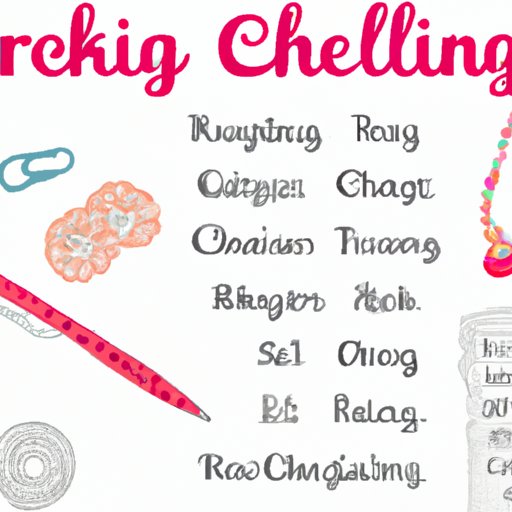
How to Read Crochet Patterns: A Beginner’s Guide
For crochet enthusiasts, the art of crocheting can bring immense joy and satisfaction. However, reading crochet patterns can be a daunting task, especially for beginners. Crochet patterns are essentially a code language that requires understanding of the terminology, abbreviations, and symbols. As a beginner, understanding a pattern may feel like deciphering a secret code. Fear not, this article is here to help guide you through the process of reading crochet patterns in a way that is beginner-friendly and easy to understand.
A Beginner’s Guide to Reading Crochet Patterns
To understand crochet patterns, it’s important to start by demystifying the language. The written instructions will include abbreviations and symbols that are commonly used in patterns. Familiarizing yourself with these terms beforehand will make reading patterns a whole lot easier. There are many tools available that provide a comprehensive list of crochet abbreviations and symbols. Additionally, many patterns include a key that spells out what each abbreviation or symbol stands for. Keep in mind that different patterns may use different abbreviations for the same stitch.
Another tip is to read the entire pattern before you even start. Getting a sense of the overall direction of the project can help you understand the intentions of the instructions more clearly. Look at the photos in the pattern as well, which will give you a visual guide of what the finished product should look like.
Decoding Crochet Patterns: Identifying Important Components
When you first look at a pattern, it might seem like a bunch of letters and numbers scattered on a page. However, there is a method to the madness. Let’s take a closer look at some of the most important components of a crochet pattern.
Stitch Abbreviations
Stitch abbreviations are a critical component of reading crochet patterns. Abbreviations can be tricky because certain stitches share the same initials (for instance, “sc” can stand for “single crochet” or “shell cluster” depending on the pattern). If you’re just starting out, it may be helpful to write out a key of stitch abbreviations to refer back to as you work through the pattern.
Gauge
Gauge is another essential component of a crochet pattern. It refers to the number of stitches and rows that are required to create a specific measurement. Every crocheter has a different tension and if your gauge is too small or large compared to the pattern instructions, your finished project may not turn out as intended. Test your gauge before starting the project to ensure that your stitch size matches the pattern’s requirements.
Notion List
The notion list is a section that lists all the supplies and tools that you’ll need to complete the project. Make sure you have everything on the list before starting so that your project won’t be interrupted.
Tips and Tricks for Reading Crochet Patterns
Let’s face it, sometimes patterns can be confusing. If you’re having trouble understanding a pattern, try these tips and tricks to help improve your crochet pattern reading skills:
Write it Out
Write out the instructions line by line in your own words before you start crocheting. Doing so will give you a better understanding of the overall pattern and where you may need to pay special attention.
Count Your Stitches
Counting stitches is crucial to avoiding mistakes. It’s easy to lose track of where you are or skip over a stitch when you’re working on a pattern. Use stitch markers and counters to help you keep track of your stitches.
Take Your Time
Don’t rush through the pattern instructions, especially if it’s your first time. Crochet is a relaxing hobby and should be treated as such. Working through the pattern at a slow and steady pace will help you maintain accuracy and avoid errors.
Follow the Instructions: Why Reading Crochet Patterns is Essential
Following a crochet pattern is an essential part of crocheting. You may think that you can crochet something without following the pattern, but it’s important to understand the design and structural principles behind each pattern. Patterns are not just a set of instructions, they are designed to produce the desired outcome and provide a roadmap to creating your project.
Another benefit of mastering pattern reading skills is the ability to modify a pattern to suit your needs. Once you have a solid understanding of how a pattern works, you can easily make adjustments to the stitches, gauge, or sizing to fit your preferences.
Differences between Chart and Written Patterns
There are two main types of crochet patterns: written and charted. Written patterns are what we’ve been talking about so far – they use abbreviations, symbols, and written instructions to spell out how to create the crochet project. Charted patterns use a visual representation of the stitches, with each stitch represented by a symbol that denotes a specific action. Charts are great for visual learners who may struggle with language-heavy instructions. However, written patterns tend to be more common and easier to find than charted patterns.
Understanding Crochet Pattern Phrases
In addition to stitch abbreviations and symbols, you’ll also encounter common phrases throughout a crochet pattern. These phrases may be short for longer instructions or used in place of more technical language. For example, “ch” means “chain stitch” and “sk” means “skip stitch”. Here are some other common phrases and their meanings:
- “fsc” – Foundation single crochet
- “rep” – Repeat
- “st” – Stitch
- “yo” – Yarn Over
- “sc2tog” – Single crochet two stitches together

From Grid to Gorgeous
It might surprise you to learn that crochet patterns start as grids. The designer maps out the stitches one by one on graph paper, which is then translated into written instructions or a chart. When working with a crochet pattern, it’s important to remember that those boxes and lines are more than just symbols. Each mark represents a stitch that will come together to create the finished product.
To transform those boxes and lines into something beautiful, take your time and pay attention to each symbol and abbreviation. As you work through the pattern, don’t forget to enjoy the process and take pride in the progress you’ve made.
Conclusion
Congratulations, you’re now well on your way to mastering the skill of reading crochet patterns. To recap, remember to familiarize yourself with the stitch abbreviations and symbols, gauge, and notion list. Use stitch markers to help you keep track of your progress, and take advantage of the visual cues provided by charts and photos. Most importantly, don’t forget to enjoy the process and take pride in every stitch you create.





